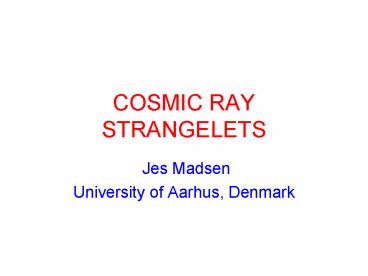COSMIC RAY STRANGELETS - PowerPoint PPT Presentation
1 / 32
Title:
COSMIC RAY STRANGELETS
Description:
Could a significant cosmic ray strangelet flux exist and be ... Spinning supermassive black holes associated with presently inactive quasar remnants[154, 155] ... – PowerPoint PPT presentation
Number of Views:47
Avg rating:3.0/5.0
Title: COSMIC RAY STRANGELETS
1
COSMIC RAY STRANGELETS
- Jes Madsen
- University of Aarhus, Denmark
2
Cosmic ray strangelets
- What are strangelets ?
- Could a significant cosmic ray strangelet flux
exist and be measured ? - A strangelet search with the Alpha Magnetic
Spectrometer (AMS-02) on the International Space
Station . - Strangelets as ultra-high energy cosmic rays ?
3
Ordinary strangelets
- Witten Farhi Jaffe
- Shell-model vs. liquid drop model
- Bulk EA
- Surface tension EA2/3
- Curvature EA1/3
B(145 MeV)4
mS50, 100, 300 MeV
Madsen, PRD 50 (1994) 3328
4
B (145MeV)4 vs. (165MeV)4
5
CFL-strangelets
Madsen, PRL 87 (2001) 172003
6
Strangelets have low Z/A
Heiselberg, PRD 48 (1993) 1418 Ordinary
strangelets
Madsen, PRL 87 (2001) 172003 CFL
0.3A2/3
8A1/3
Nuclei 0.5A
0.1A
7
Strangelet charge
- Vacuum polarisation dominates at high A gt lower
Z - Madsen Larsen,
- PRL 90 (2003) 121102
8
Cronin, Gaisser Swordy (1997)
9
Measuring strangelets at 1-1000 GV
- Find low Z/A cosmic rays with high precision
equipment in space - gt
- AMS-02
10
(No Transcript)
11
(No Transcript)
12
Alpha Magnetic Spectrometer AMS-02
International Space Station 2007/08 for 3-5 years
- PURPOSE
- Cosmic rays
- Antimatter (anti-He)
- Dark matter
- Strangelets
13
(No Transcript)
14
(No Transcript)
15
(No Transcript)
16
Choutko (MIT)
17
Strangelets from strange star binary collisions
- 1 binary neutron star collision per 10.000
years in our Galaxy - Release of 10-6 solar masses per collision
- Basic assumptions
- SQM absolutely stable!
- All mass released as strangelets with mass A
(fluxes for mass A give lower limit of flux if
mass spectrum of masses below A)
18
Strangelet propagation
- Acceleration in supernova shocks etc
- Source-flux powerlaw in rigidity
- Diffusion in galactic magnetic field
- Energy loss from ionization of interstellar
medium and pion production - Spallation from collision with nuclei
- Escape from galaxy
- Reacceleration from passing shocks
19
Cosmic strangelet fluxZ8, A138 CFL
Flux (per year GV sqm sterad)
Source
Interstellar
Solar System
Madsen (2004) PRELIMINARY
Rigidity (GV)
20
Cosmic strangelet fluxZ8, A138 CFL
Flux above R (per year sqm sterad)
Interstellar
Solar System
Source
Madsen (2004) PRELIMINARY
Rigidity (GV)
21
Total CFL-strangelet flux
Total flux (per year sqm sterad)
No geomagnetic cutoff
Interstellar
Solar System
Madsen (2004) PRELIMINARY
Z
22
Total CFL-strangelet flux
Total flux (per year sqm sterad)
No geomagnetic cutoff
Interstellar
Solar System
Madsen (2004) PRELIMINARY
A
23
Cronin, Gaisser Swordy (1997)
24
Is there a GZK-cutoff ?
Abbasi et al. (High Resolution Flys Eye
Collaboration), PRL 92 (2004) 151101
25
Why are strangelets interestingas ultra-high
energy cosmic rays?Madsen Larsen, PRL 90
(2003) 121102
- Avoids the acceleration problem of ordinary
UHECR candidates - Avoids the GZK cut-off from interaction with 2.7K
cosmic microwave background
26
Why are strangelets interestingas ultra-high
energy cosmic rays?Madsen Larsen, PRL 90
(2003) 121102
- ZSTRANGELET gtgt ZNUCLEUS possible
- ?
- Better acceleration in known sources
- (EMAX RMAX Z RMAX magn.field x size)
- Rigidity R p/Z ( E/Z if relativistic)
27
Hillas-plot for E(max)1020eV
Stecker/Olinto (2000)
28
Hillas-plot for E(max)1020eV
Strangelet Z104
29
Why are strangelets interestingas ultra-high
energy cosmic rays?Madsen Larsen, PRL 90
(2003) 121102
- Less susceptible to GZK-cut-off from
high-Lorentz-factor interactions with 2.7K
CMB-photons because of - High A
- Low Z/A
30
Eliminating the GZK-cutoff
- Photo-pion production cut-off at
- b) Photo-disintegration at
- Photo-pair-production above
31
Plausible sources for UHECRs (Anchordoqui et
al. Int.J.Mod.Phys.A18 (2003) 2229
- Supernovae explosions 147, 148.
- Large scale Galactic wind termination shocks
149. - Pulsars (neutron stars) 150.
- Active galactic nuclei (AGNs) 151.
- BL Lacertae (BL Lac) a sub-class of AGN 152,
153. - Spinning supermassive black holes associated
with presently inactive quasar remnants154, 155 - Large scale motions and the related shock waves
resulting from structure formation in the
Universe 157 such as accretion flow onto galaxy
clusters and cluster mergers 158, 159. - Relativistic jets and hot-spots produced by
powerful radiogalaxies. 161, 162, 163. - The electrostatic polarization fields that
arise in plasmoids produced in planetoid impacts
onto neutron star magnetospheres 166. - Magnetars pulsars with dipole magnetic fields
approaching 1015 G 167, 168, 169 appear also
as serious candidates 170, 171. - Starburst galaxies 172, 173, 174.
- MHD winds of newly formed strongly magnetized
neutron stars 175. - Gamma ray burst (GRB) fireballs 176, 177, 178,
179. - Strangelets, stable lumps of quark matter,
accelerated in astrophysical environments 180. - Hostile aliens with a big CR gun 181.
32
Conclusions
- Strangelets have low Z/A
- CFL and non-CFL strangelets differ wrt. Z
- Experimental verification/falsification of
- Strangelet existence
- Realistic from AMS-02 2007/8 for 3-5 years
- Possible from lunar soil search experiment
Sandweiss et al. (Yale) Fisher et al. (MIT)
Madsen (Aarhus) 2004 - (A,Z)-relation (CFL or ordinary)
- Optimistic, but not impossible from AMS-02 or
perhaps lunar soil search
33
Detection of UHECRs (Anchordoqui et al.
Int.J.Mod.Phys.A18 (2003) 2229
34
(No Transcript)































